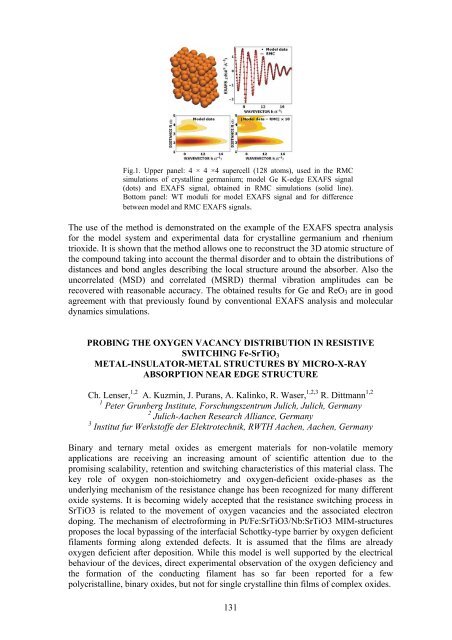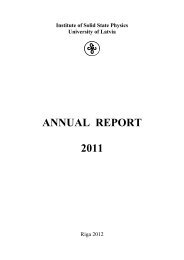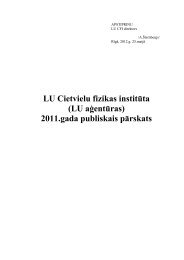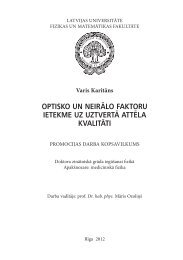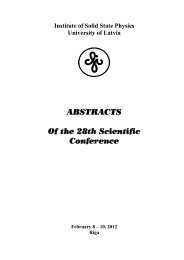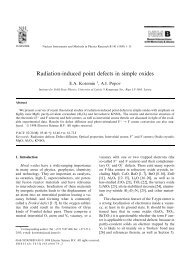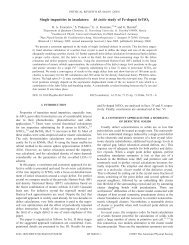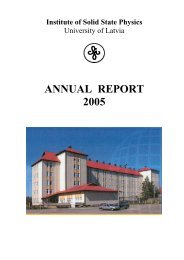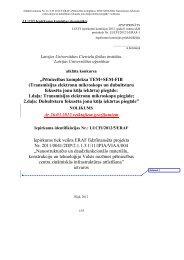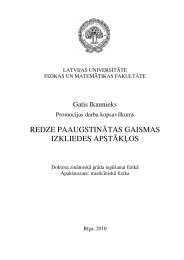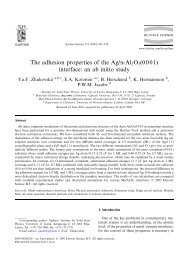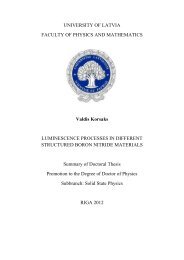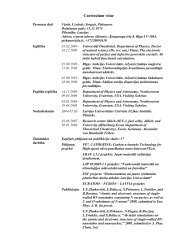Annual Report 2012 - Latvijas Universitātes Cietvielu fizikas institūts
Annual Report 2012 - Latvijas Universitātes Cietvielu fizikas institūts
Annual Report 2012 - Latvijas Universitātes Cietvielu fizikas institūts
You also want an ePaper? Increase the reach of your titles
YUMPU automatically turns print PDFs into web optimized ePapers that Google loves.
Fig.1. Upper panel: 4 × 4 ×4 supercell (128 atoms), used in the RMC<br />
simulations of crystalline germanium; model Ge K-edge EXAFS signal<br />
(dots) and EXAFS signal, obtained in RMC simulations (solid line).<br />
Bottom panel: WT moduli for model EXAFS signal and for difference<br />
between model and RMC EXAFS signals.<br />
The use of the method is demonstrated on the example of the EXAFS spectra analysis<br />
for the model system and experimental data for crystalline germanium and rhenium<br />
trioxide. It is shown that the method allows one to reconstruct the 3D atomic structure of<br />
the compound taking into account the thermal disorder and to obtain the distributions of<br />
distances and bond angles describing the local structure around the absorber. Also the<br />
uncorrelated (MSD) and correlated (MSRD) thermal vibration amplitudes can be<br />
recovered with reasonable accuracy. The obtained results for Ge and ReO 3 are in good<br />
agreement with that previously found by conventional EXAFS analysis and molecular<br />
dynamics simulations.<br />
PROBING THE OXYGEN VACANCY DISTRIBUTION IN RESISTIVE<br />
SWITCHING Fe-SrTiO 3<br />
METAL-INSULATOR-METAL STRUCTURES BY MICRO-X-RAY<br />
ABSORPTION NEAR EDGE STRUCTURE<br />
Ch. Lenser, 1,2 A. Kuzmin, J. Purans, A. Kalinko, R. Waser, 1,2,3 R. Dittmann 1,2<br />
1 Peter Grunberg Institute, Forschungszentrum Julich, Julich, Germany<br />
2 Julich-Aachen Research Alliance, Germany<br />
3 Institut fur Werkstoffe der Elektrotechnik, RWTH Aachen, Aachen, Germany<br />
Binary and ternary metal oxides as emergent materials for non-volatile memory<br />
applications are receiving an increasing amount of scientific attention due to the<br />
promising scalability, retention and switching characteristics of this material class. The<br />
key role of oxygen non-stoichiometry and oxygen-deficient oxide-phases as the<br />
underlying mechanism of the resistance change has been recognized for many different<br />
oxide systems. It is becoming widely accepted that the resistance switching process in<br />
SrTiO3 is related to the movement of oxygen vacancies and the associated electron<br />
doping. The mechanism of electroforming in Pt/Fe:SrTiO3/Nb:SrTiO3 MIM-structures<br />
proposes the local bypassing of the interfacial Schottky-type barrier by oxygen deficient<br />
filaments forming along extended defects. It is assumed that the films are already<br />
oxygen deficient after deposition. While this model is well supported by the electrical<br />
behaviour of the devices, direct experimental observation of the oxygen deficiency and<br />
the formation of the conducting filament has so far been reported for a few<br />
polycristalline, binary oxides, but not for single crystalline thin films of complex oxides.<br />
131


